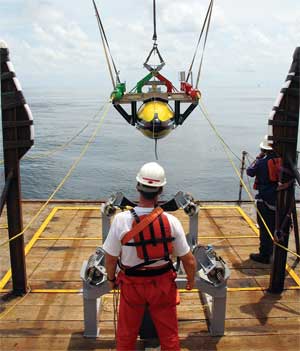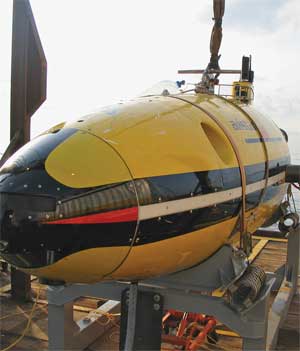Technology from Europe: France
AUVs continue to improve and evolve in capability
Operators now have options, especially in deep water, for ROVs, AUVs and hybrids, whether for survey, inspection or intervention.
Some day, Autonomous Underwater Vehicles (AUVs) will be truly autonomous—dropped off at sea on Tuesday, retrieved on Thursday at some pre-designated location, many miles away from their drop-off point. We’re still several years away from such a device, but rapid development of increasingly autonomous vehicles—with little more than occasional acoustic communication with a technician on a vessel, perhaps a mile or more overhead—now makes this possible. Today’s AUVs can survey pipelines, flowlines, drilling and mooring locations, act as deployment shuttles for ROVs, and even do sub-bottom profiling (a shallow-penetrating seismic).
Oil companies are increasingly using AUVs because they save money compared to ROV inspections and deep towed surveys. Most of the savings come from the fact that the AUVs can get the job done much more quickly, travelling at up to 5 kt, with bursts even higher. In addition, sea state is less of a factor, and the support vessel need not be as specialized. Also, resolution of the data is usually much better.
French firm ECA, based in Toulon, has been working on its AUV version, called the Alistar, since early 2000. The primary mission is to get the job done more quickly and with better data, and as autonomously (minimal communication with the ship) as possible. This AUV inspects structures, risers and mooring lines, through automated bottom-following and pipeline/line-following.
After some years designing and constructing shallow-water and deepwater prototypes, sea trials first took place in 2002, and there has been at least one trial each year since. Last July, another deepwater trial of the Alistar 3000 AUV took place in the Gulf of Mexico for BP America. This trial was carried out as part of the BP Exploration and Production Technology Group field trial program.
This AUV is 5 m long and weighs 2,300 kg (1,045 lb), including a 200-kg payload (see figures). It uses thrusters for maneuvering, which allows it to hover, or travel up to 6 kt. The AUV successfully carried out a pre-programmed inspection mission in deep water without a physical link to the surface. The deepwater trials took place with the local support of ECA’s partner in the USA, Harvey Lynch Inc. The vehicle was launched from an Oceaneering vessel hired by BP. The Alistar executed numerous missions at 4,450 ft on a 9-in. x 13-in. pipe-in-pipe flowline around BP’s King field. The AUV successfully:
- Repositioned accurately close to seabed after descent
- Kept acoustic supervision from the surface throughout the mission
- Validated a sophisticated mission-management system
- Found and “locked onto” a pipeline after searching
- Tracked and closely followed a pipeline between 1 and 2 m above the pipe, recording high-quality video images
- Detected and carried out close inspection of an anomaly, using dedicated patterns
- Safely recovered to the surface.
|
|
The Alistar 3000 undergoing sea trials.
|
|
Based in Marseille, France, Cybernetix, in co-operation with Ifremer, the University of Liverpool and Total (then TotalFinaElf), set up and undertook two major R&D programs. The first, the now well-known Swimmer, is an AUV-shuttle designed to deliver a conventional work-ROV to a subsea docking station. It then connects to surface production facilities through a pre-installed power/control umbilical on the sea floor.
This hybrid underwater vehicle concept is kept permanently on location, such as an FPSO or platform. The associated Opex is low. It allows traditional ROV work, but eliminates the support vessel, because its extended range of operation allows launch and recovery from surface production facilities.
As water depth increases, the cost of traditional ROV operations for inspection, maintenance and repair tasks of subsea installations becomes a significant part of the field’s operational expenditures. The hybrid AUV/ROV deploys an ROV on a deepwater field without the need for long and heavy umbilicals, special support vessels and their associated costs. A standard ROV is automatically carried by the AUV shuttle to a subsea docking station installed close to equipment that requires regular maintenance interventions, such as wellheads and manifolds.
The docking station is linked to the surface via a permanent umbilical, which allows powering and real-time control of the ROV when the AUV shuttle is connected to the subsea station. The system is in operation on a few Total/Statoil-operated platforms.
Cybernetix also has an AUV called Alive, which is capable of light interventions on deepwater subsea facilities without needing a dedicated DP support vessel. The vehicle has its own DP system, as well as auto-docking capability, and is equipped with a seven-function manipulator for light interventions.
Probably the most successful commercial AUV is the Hugin by Norway’s Kongsberg Marine. The company says that, altogether, Hugin has surveyed a distance of 120,000-line km of seabed for offshore survey companies. C&C Technologies operates three Hugins,
Fugro just ordered its second, and Geoconsult has one.
Following on the heels of its successful 1,000-m and 3,000-m version, the Hugin 4,500 was recently released. While the amount of exploration in 15,000-ft waters is small, if any, if there’s a need, this AUV can handle it. Not only can the new Hugin handle 4,500-m depths, other technology has also been improved. The company says that battery capacity has been increased by 30%, as well as more advanced sonar and echo sounder systems that feature higher resolution and more precise measurements. 
|




